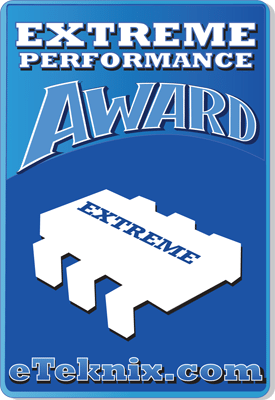Antec Edge 650W Modular Power Supply Review
Ryan Martin / 10 years ago
Introduction & Packaging
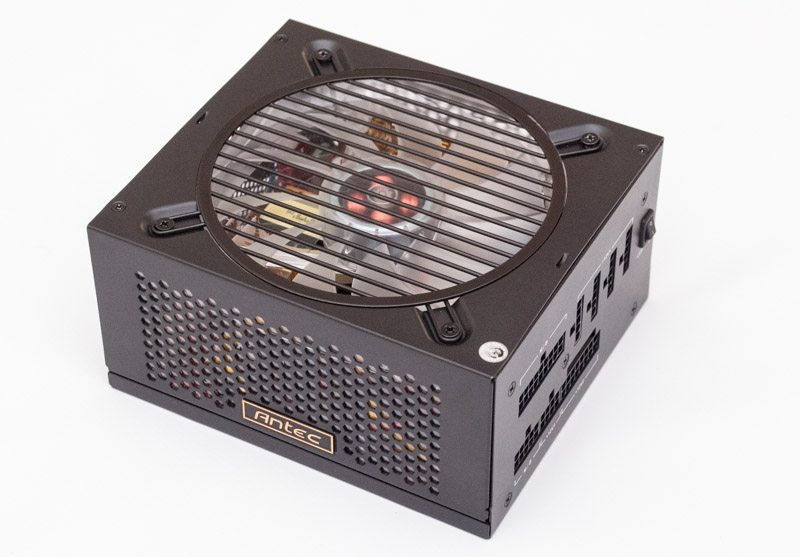
Today Antec are unveiling a brand new power supply series which they are calling the “Edge” series. Some of the key features of the Antec Edge power supply series are a fully modular design, 80 Plus Gold certification, Antec’s respected 5 year warranty, custom rubber sleeving and quiet operation. That all sounds very good doesn’t it? Antec have clearly been listening to end user feedback because on paper the Edge 650W looks like a perfect power supply for the majority of enthusiast PC users. If we compare the Edge to Antec’s High Current Gamer series we can see obvious improvements in noise and aesthetics and compared to the High Current Pro series we can see obvious improvements in pricing. The Antec Edge 650 has a competitive price tag of $129.99 MSRP, so let’s find out if it has the performance as well!
Packaging and Contents
Antec’s packaging is a little more flashy than last time with a fairly elaborate picture of the product. Antec proclaims that this PSU is Haswell ready meaning it supports C6 and C7 sleep state functions.
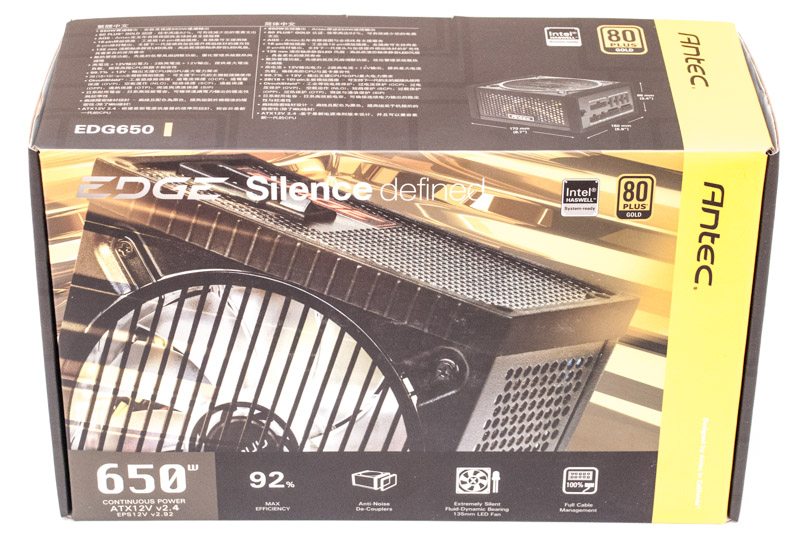
Key specifications and cable configurations are displayed on the side of the box.
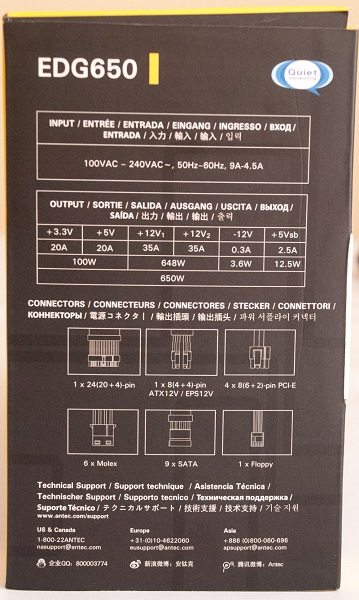
The accessories package includes a power cable, warranty documentation, a user manual, two sets of custom rubber bumpers in red & black and four silver mounting screws.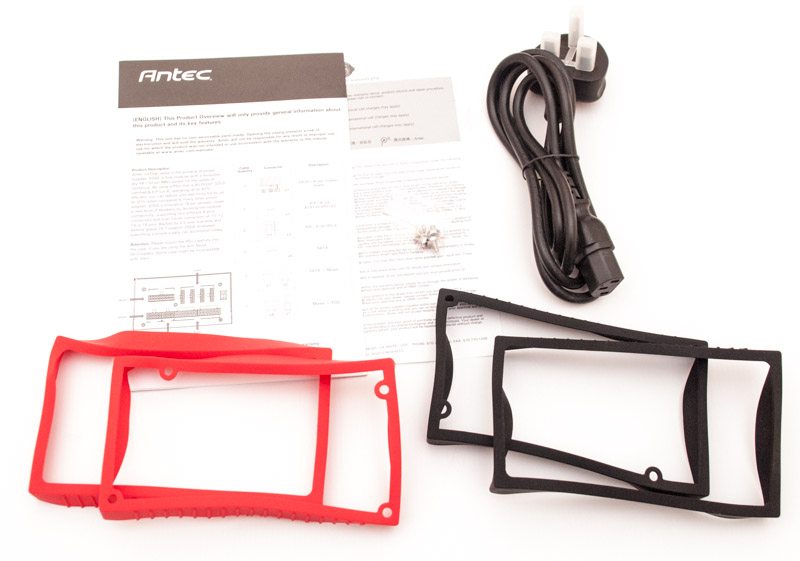
A Closer Look – Exterior
Power Supply Unit
Antec’s Edge 650 starts off with a new fan design; with the fan being a clear LED variant underneath a circular edged fan grille.
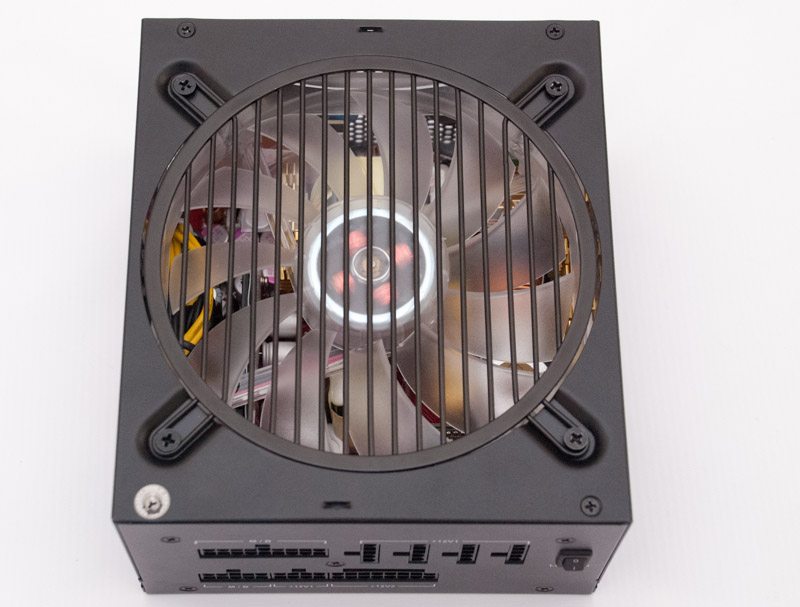
At the cable-end of the unit we find an LED on/off switch and all of your modular connectors. Antec provide two 12 volt rails; one for the motherboard, CPU and peripherals, and the other is for the PCIe.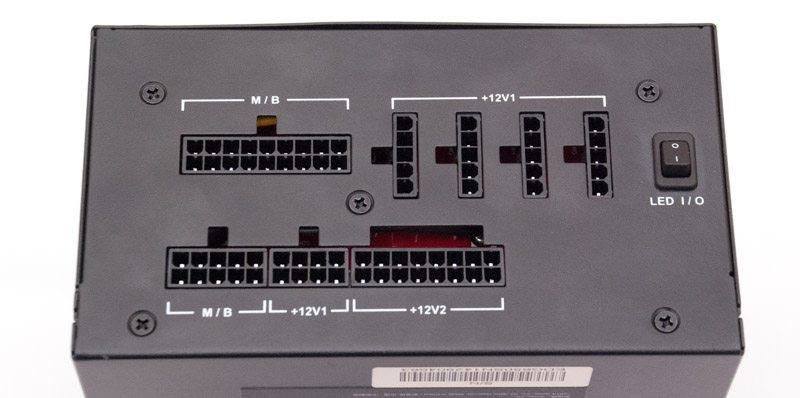
On both sides we find a hexagonal mesh design sporting a gold-tinted Antec logo. These are reversed depending on your mounting preference: fan up or fan down.
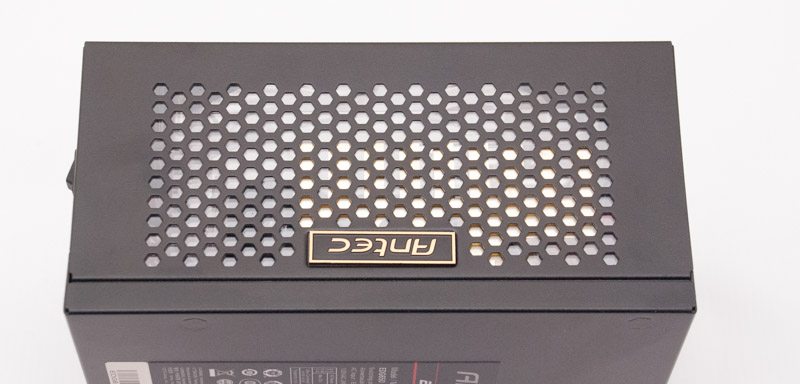
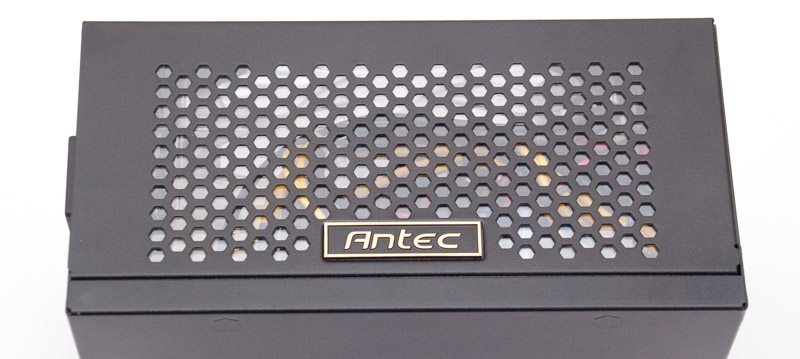
Around the back is more mesh for exhausting hot air, a power switch, kettle lead input and the Antec Edge branding.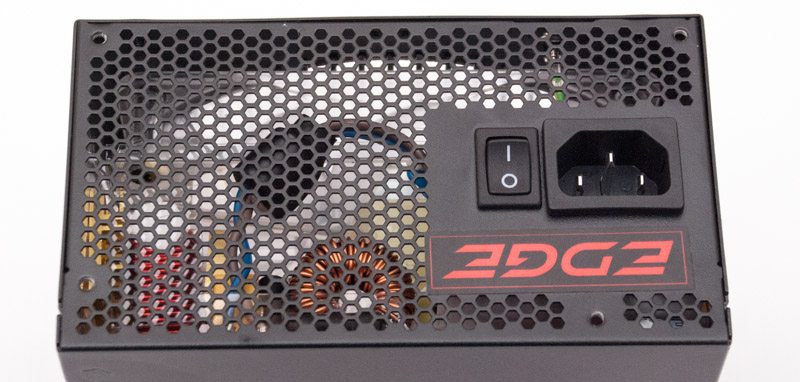
On the base of the unit is a sticker detailing all certifications and key specifications.
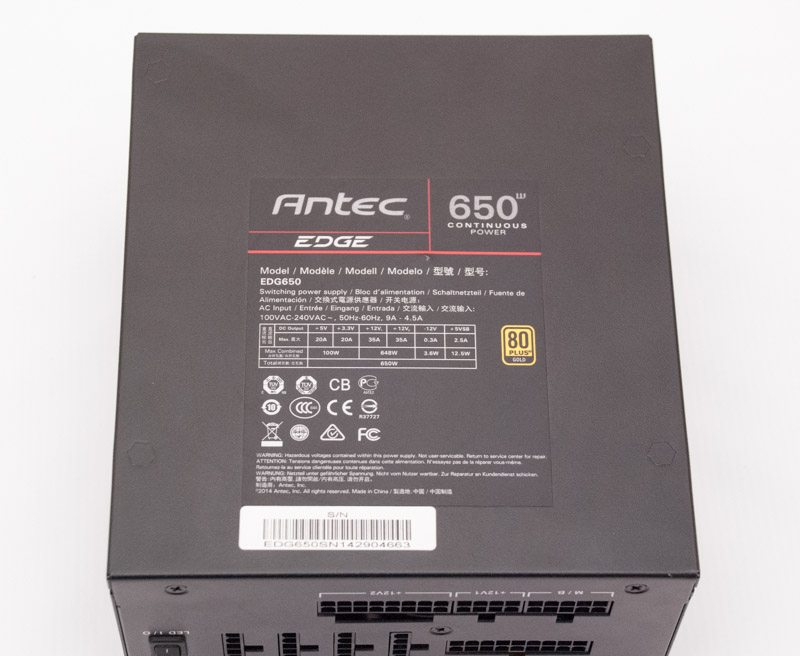
Cabling
In terms of cables Antec provide 9 SATA, 6 Molex and 1 FDD for peripherals.
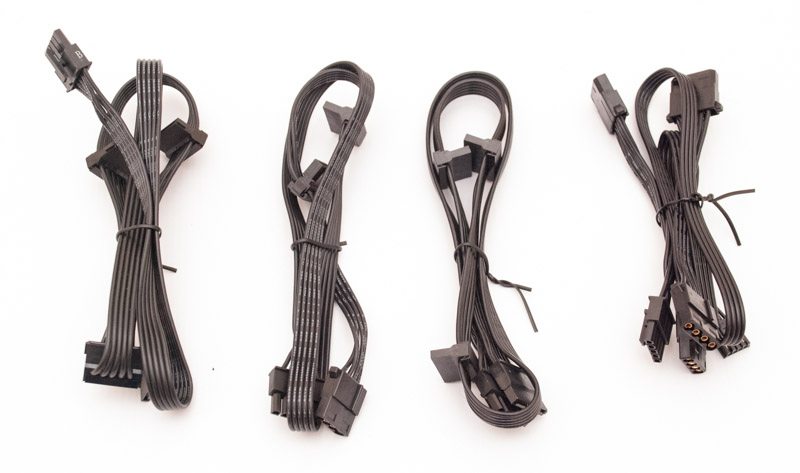
For the rest of your system there is a 24 pin motherboard connector, an 8 pin (4+4) CPU connector and four 6+2 pin PCIe connectors. Antec offer the perfect number of cables for a PSU of this wattage.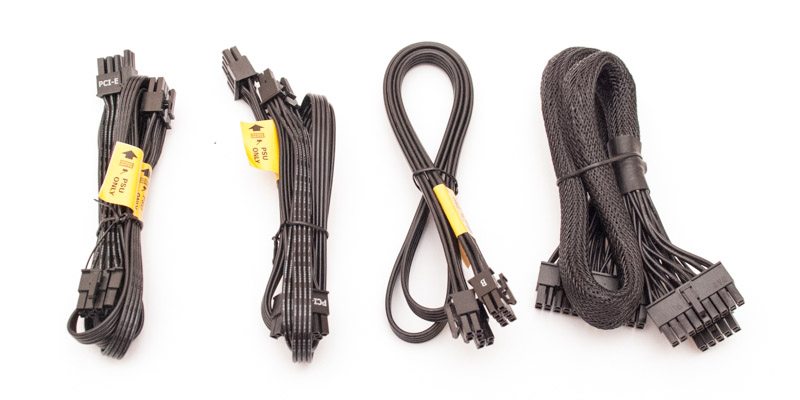
A Closer Look – Interior
The OEM for Antec’s Edge 650W power supply is Seasonic according to Antec. This doesn’t really surprise us as Antec have a long history of cooperation with Seasonic on power supplies. Given this fact, it isn’t strange to see the internal layout is very well thought out with high quality soldering and smart heatsink placement.
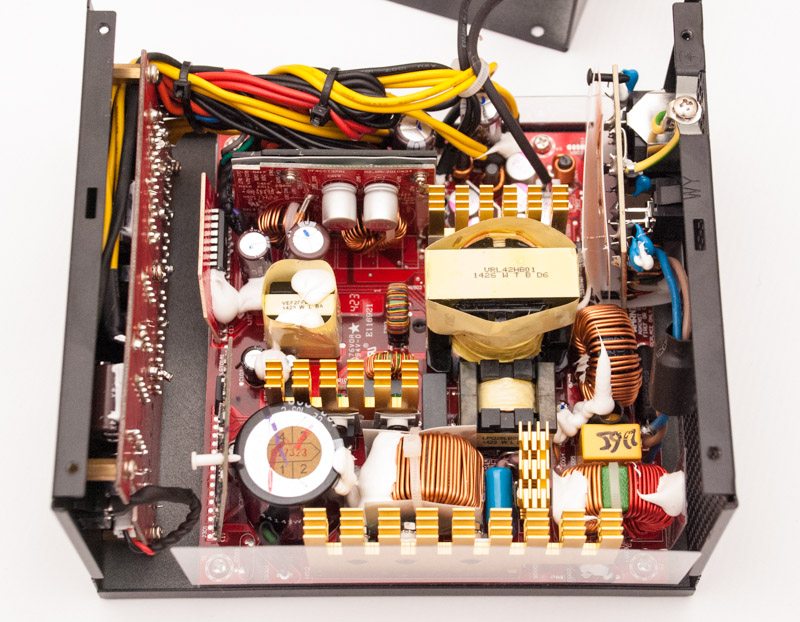
The unit is cooled by a 135mm fan which is temperature controlled up to 2000 RPM. It bears the part number HA13525H12F-Z.
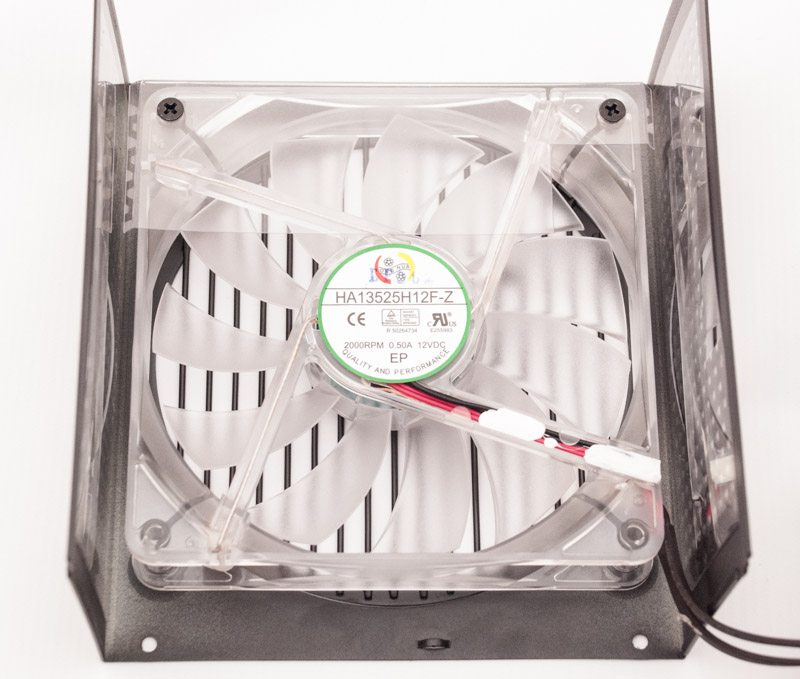
As with most Seasonic OEM designs there is a significant amount of AC line filtering that takes place at the back of the PSU.
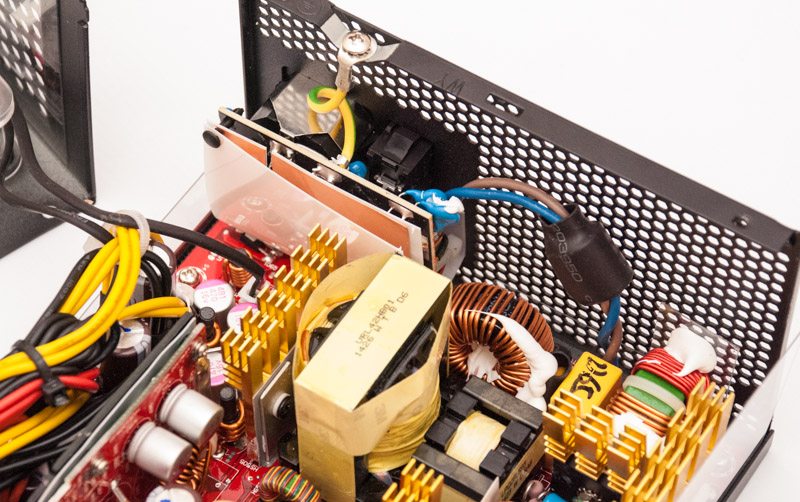
A large 105 degrees Celsius rated 390 uF Rubycon capacitor supplies the primary side.
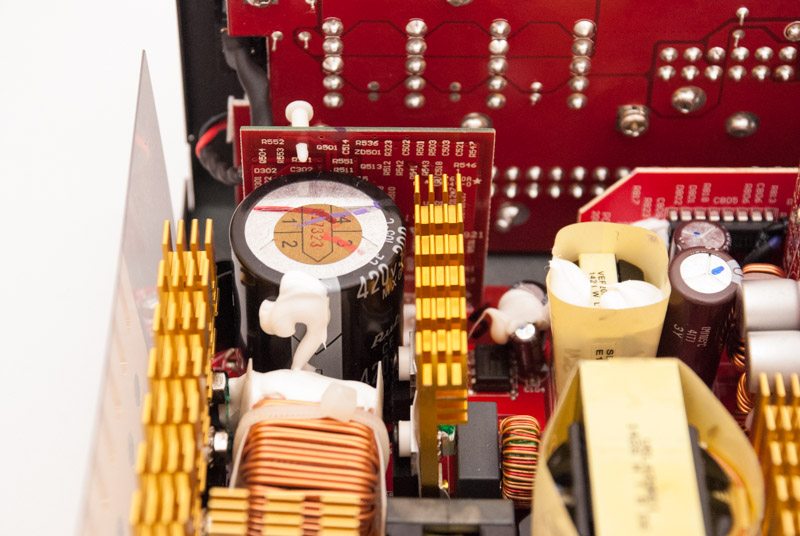
Nippon Chemi-Con (Japanese) capacitors supply the secondary side.
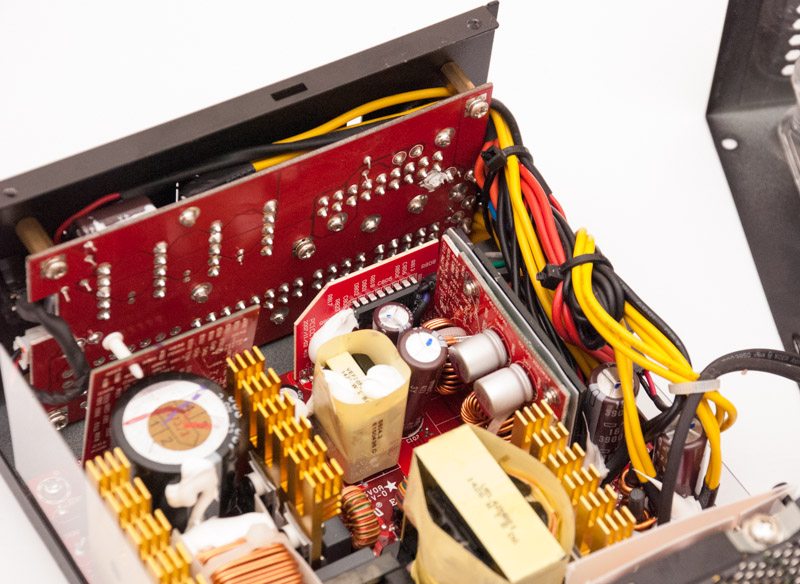
Test Procedure
At eTeknix we take the power supply testing procedure very seriously and have invested a lot of resources into acquiring the appropriate testing equipment. For all power supply reviews we test the power supplies with dedicated power supply testing equipment. This means we are able to get the most accurate results from our testing as opposed to using software benchmarks (such as OCCT) or multi-meter readouts which are broadly inaccurate.
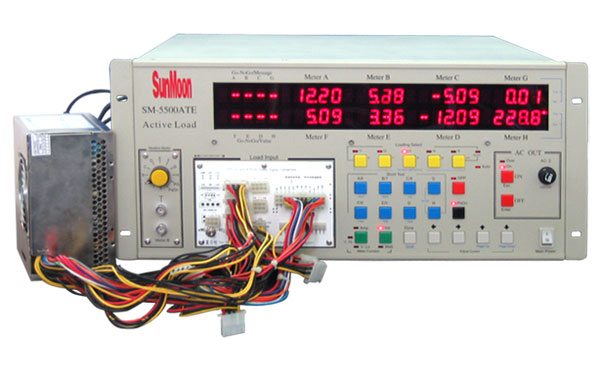
Our test machinery is as follows:
- Sunmoon SM-5500ATE Active Load Tester (1200W rated)
- Stingray DS1M12 USB Oscilloscope
- Voltcraft DT-10L laser tachometer
The eTeknix test procedure involves:
- Testing each power supply at 20/40/60/80/100% load (with balanced load across all rails) and measuring PFC (power factor correction), efficiency (actual power divided by power “pulled at the wall”) and voltage regulation (deviance from expected voltages of 3.3/5/12 on the main rails).
- Measuring ripple with an oscilloscope at 20/40/60/80/100% load.
- Measuring fan speed after a stabilisation period of five minutes at each load scenario using the Voltcraft DT-10L laser tachometer and a reflective strip on the fan.
- Testing each power supply’s OPP (Over Power Protection) mechanism and seeing how many watts each power supply can deliver before shutting down
Other things to consider are that
- We recognise that a single yellow 12 volt cable can provide only 6 Amps before overheating (which corrupts voltage regulation and efficiency) and so we used an adequate number of cables for each power supply to ensure there is not efficiency loss from poor cables selection
- Our Sunmoon SM-5500ATE power supply tester is not capable of testing more than 300W on each of the 12 volt rails so where a power supply provides more than 300W on a 12 volt rail that power is distributed over multiple 12 volt rails on the load tester. For example a power supply with one 12 volt rail supplying 750 watts would be spread equally over three 12 volt rails on the load tester, a power supply with two 450W 12v rails would be spread over four 12v rails on the load tester, two 225W 12v rails for each of the 12v rails on the unit.
- We use the same time scale and horizontal millivolt scale on our oscilloscope for all ripple tests, that is a 20ms T/DIV (horizontal) and a 0.02 V/DIV (vertical) meaning the scale is from -80mV to +80mV, ATX spec dictates that the 12v rail must fall within 150mv of ripple and the 3.3/5 within 50mv so that scale allows us to include both 150 and 50mV peaks. (Some older PSU reviews use different scales which were later ditched as the visual representation they give is inadequate, in these reviews written measurements are provided only).
- Deviance is the terminology used to represent the way voltages diverge from the expected values
Efficiency, PFC and Voltage Regulation
Voltage Regulation
To test voltage regulation we load the power supply to five different load scenarios that give an equal spread of load across every single rail. So that means 20% on all rails, 40% on all rails and so on. We then calculate the average deviance of each rail from its expected voltage.

Voltage regulation on the Antec Edge 650 is very strong and conforms to Seasonic’s usual pledge of +- 2% on the major rails.
Power Efficiency
Power efficiency is measured by calculating actual supplied wattage divided by the wattage drawn at the wall/plug, multiplied by 100 to give a percentage. We then compare that to the particular 80 Plus certification the company claims to see if it meets that. You can see the 80 Plus certifications below, we always test 230v power supplies.
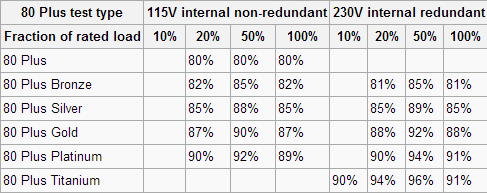
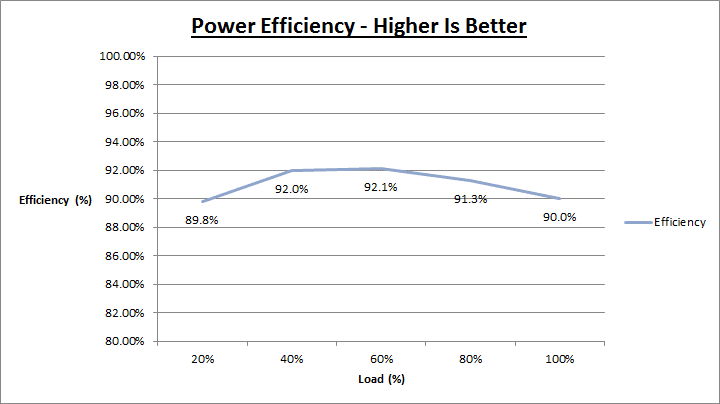
The Antec Edge 650W is rated for 80 Plus Gold but slightly exceeds that at 20% and 100% levels. Efficiency is close to Platinum level.
Power Factor Correction
Power Factor Correction is the ratio of the real power flowing to the load, to the apparent power in the circuit. The aim of PFC is to make the load circuitry that is power factor corrected appear purely resistive (apparent power equal to real power). In this case, the voltage and current are in phase and the reactive power consumption is zero. The closer the number to one the better as this allows the most efficient delivery of electrical power (Source – Wikipedia).
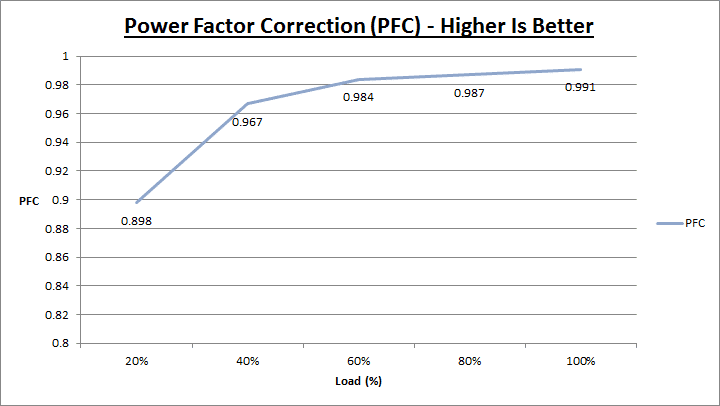
Seasonic’s PFC is always strong and this continues with the Antec Edge 650W. Only at 20% load was the PFC a little mediocre.
Ripple
Noise and Ripple can easily be measured by an oscilloscope. These show how much voltage fluctuation there is on a particular rail. We tested the rail stability of the 3.3 volt, 5 volt and 12 volt rails using an identical time and millivolt scale for all graphs. millivolt ripple is measured by the peak to peak size of the voltage curve.
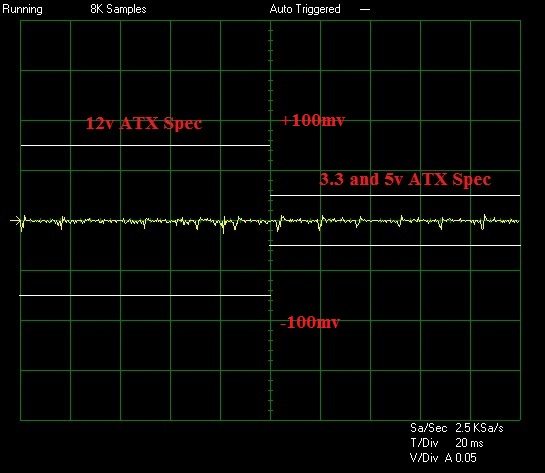
Sample Ripple Graph
The latest ATX 12 volt version 2.3 specifications state that ripple from peak to peak must be no higher than 50 millivolts for the 3.3 volt and 5 volt rails, while the 12 volt rail is allowed up to 120 millivolts peak to peak to stay within specifications. Millivolt figures are stated to the closest increment of 5 given their variability.
| Load (%) | 3.3V Ripple | 5V Ripple | 12V Ripple |
| 20 | 3mV | 4mV | 10.2mV |
| 40 | 3.4mV | 4.4mV | 14.8mV |
| 60 | 3.6mV | 5mV | 23.4mV |
| 80 | 4mV | 7.4mV | 25.4mV |
| 100 | 7.2mV | 12mV | 32.8mV |
The ripple results speak volumes about the Seasonic OEM design used. All major rails had excellent performance and kept well within ATX specs. Check out the 100% load shots below:
3.3 volts @ 100%
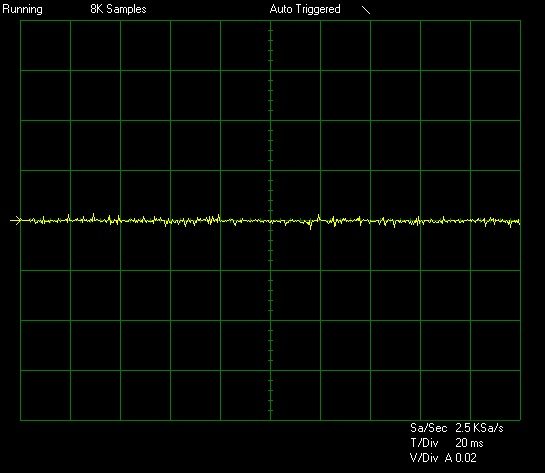
5 volts @ 100%
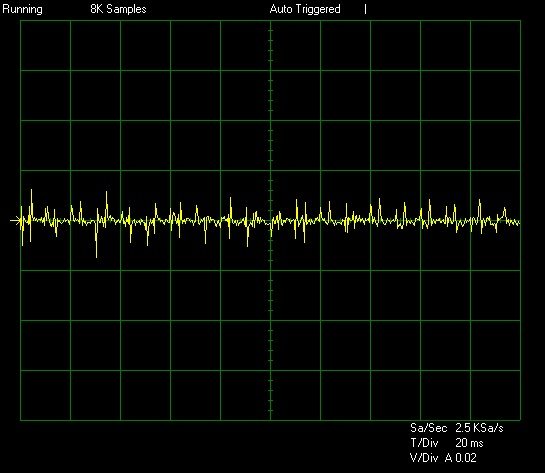
12 volts @ 100%
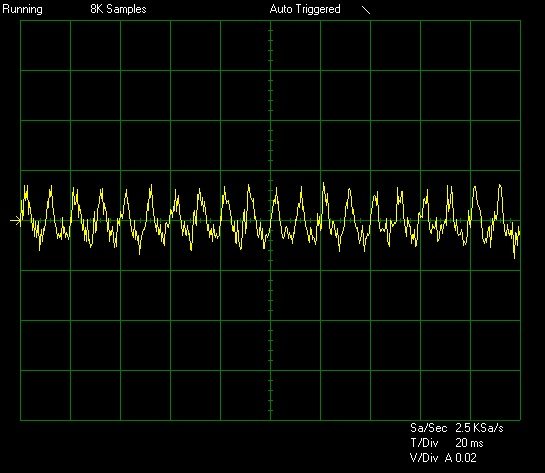
Over Power Protection and Max Wattage
Power supplies often quote as having various protection mechanisms such and the most important of these is Over Power Protection. In our testing we crank up the power draw until the power supply either shuts down (meaning the OPP mechanism is present and working) or blows up (meaning it is either not present or not working). We then note the maximum power consumption before the power supply shut down (or blew up).

No Seasonic power supply has blown up on my watch and the Antec Edge doesn’t change that trend. It only managed an extra 70W above its rated wattage before the OPP was triggered but we can’t complain as it delivers its rated wattage safely.
Fan Speed
When testing in a power supply laboratory it is difficult to take fan noise readings as the noise from the Sunmoon test equipment and air conditioning corrupts everything. The next best thing in our circumstances was reading off the fan speed with a tachometer to get an idea for the noise. The ambient temperature during testing held constant at 22 degrees, with 1 degree of variation. Each power supply had a consistent time period of 5 minutes to stabilise between each load scenario.
In my experience the following general relationships apply between noise levels and fan speeds, though it can vary greatly between the type of fan used.
- Below 800 RPM – Inaudible/Silent
- 800 to 1000 RPM – Barely audible
- 1000 – 1200 RPM – Audible but still quiet
- 1200 – 1400 RPM – Moderately noisy
- 1400 – 1800 RPM – Noisy
- 1800 RPM or higher – Intolerable
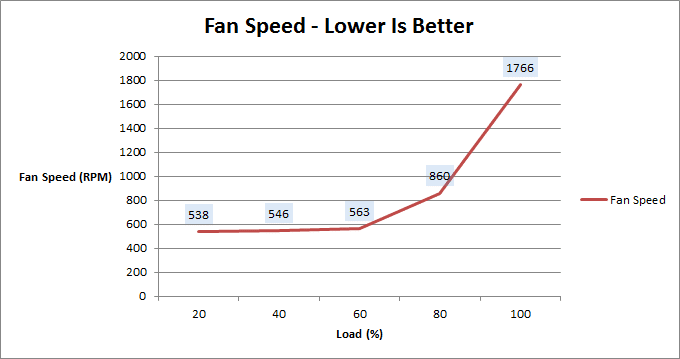
The fan was very quiet up until 100% load when things jumped up significantly. You’re unlikely to be at or anywhere near 100% very often so broadly speaking the Antec Edge is an incredibly quiet power supply.
Final Thoughts
Pricing
Antec’s Edge 650W has an MSRP of $150 USD and comes with a 5 year warranty. EU pricing is €145.99 and UK pricing is £90. You can pre-order it now from Scan in the UK.
Conclusion
The Antec Edge 650W boasts very strong performance in all aspects of what makes a good power supply. On the aesthetic front the fully modular design with all black cables is an excellent choice and the LED fan compliments things well. If the white LED isn’t to your taste Antec even give the option to turn it off. Furthermore, Antec provide two sets of rubber end-pieces for the Edge 650 allowing you to keep it stealth black or go for a red accent. The new fan grille design from Antec is also pretty sweet; it makes a nice change for the usual hexagonal mesh.
Moving over to performance and we see the Antec Edge 650W offers all of the hallmarks of a high quality Seasonic platform: quiet operation, high efficiency & PFC, strong voltage regulation and excellent ripple suppression. The only blemish on an otherwise superb performer was the hike in fan speed at 100% load which seemed unnatural and was unnecessary: the unit simply doesn’t get hot enough to justify 1700 RPM at full load.
Where does this unit stand given its hefty price? I think we can assume that the Antec Edge 650 will arrive to market cheaper than its MSRP as most power supplies do tend to. Right now it is hard to make a concrete judgement about the Edge 650 given the uncertain pricing but we can see that it faces stiff competition from a lot of rival power supplies. Take for example, the BitFenix Fury 650G (€140), the Corsair RM650 (€105), the Super Flower Leadex Gold 650W (€110) and the Silverstone Strider Gold 650W (€120) [prices accurate at time of writing]. Of course not all of these rival power supplies have a fully modular design, all black cables, changeable anti-vibration end-pieces, LEDs and such strong internal performance. Antec always hold a premium over other brands because Seasonic platforms are expensive: but the extra expense is justified due to the high performance.
Simply put, there are other alternatives that offer better value for money, but the Antec Edge 650W is a fantastic power supply nonetheless. Keep an eye on pricing because it is definitely worth buying if you can afford it and appreciate the extra quality.
Pros
- Higher than certified efficiency
- Strong +- 2% voltage regulation
- Impressive ripple suppression
- Quiet under most load scenarios
- Fully modular with all black cables
- LED fan and end-pieces – ability to “accessorise” your PSU’s aesthetics
- 5 year warranty
Cons
- Expensive (but not for UK buyers!)
- Loud fan at 100% load
“Antec’s Edge 650W may be expensive, but it has a flawless design and a ton of features. This power supply is well worth considering if you’re building an extreme performance system.”
Thank you to Antec for providing this review sample.
